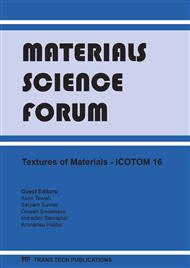p.370
p.374
p.378
p.385
p.391
p.398
p.402
p.406
p.411
Formation and Development of Strong Cube Recrystallization Texture in an Aluminium of Commercial Purity
Abstract:
The goal of the present study inspired by previous works on high purity aluminiun was to manufacture aluminium sheets of commercial purity, grade 1050, with a strong cube texture. In this preliminary work on AA1050, sheets which cube volume fraction reaches 65% have been manufactured. Parameters controlling cube orientation development are mainly the solute dragging due to impurities in solid solution and the stored deformation energy. Besides the 85% cold rolling (CR), two extra annealings and a slight cold rolling are introduced in the processing route to increase the cube volume fraction. The cube orientation, whose substructure is equiaxed, is important for its recovery. It develops thanks to the difference of stored energy relative to that of its first neighbors; the slight cold rolling enhances growth of these cube grains.
Info:
Periodical:
Pages:
391-397
Citation:
Online since:
December 2011
Keywords:
Price:
Сopyright:
© 2012 Trans Tech Publications Ltd. All Rights Reserved
Share:
Citation:


